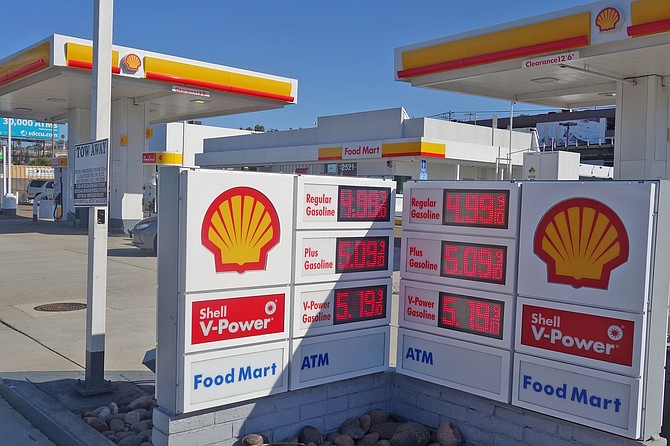 Facebook
Facebook
 X
X
 Instagram
Instagram
 TikTok
TikTok
 Youtube
Youtube

It seems President Trump was correct in his assumption that the Saudi Arabia oil field bombing would not send the world’s gas prices into a tizzy. The U.S. is now the world’s largest exporter of oil, and the Saudis are repairing damaged refineries, and their gas and oil is flowing again.
“The national average is moving lower, but don’t tell California,” posted Patrick DeHaan, a leading petroleum analyst. According to gasbuddy.com, San Diegans have experienced a 60-cent-per-gallon price jump since the September 14 refinery attacks.
The summer saw stable gas prices in San Diego, averaging $3.50-$3.60 per gallon (regular gas, cash price) throughout the county. On September 15, the day after the attacks, prices began to spike, sometimes up 10 cents a day. Most stations are now over the $4 threshold, the average is $4.20 countywide – prices not seen since July of 2015.
“Prices skyrocketed due to concern that four [California] refineries suffering various outages would impact production of gasoline,” reported DeHann. DeHaan expects California prices to rise another 10-20 cents before leveling off.
The highest priced stations in the county seem to have not been affected by the price spike. El Cajon's Chevron station on North Magnolia Avenue at East Madison Avenue, always reported as one of the highest priced stations in the county, has been fairly constant over the summer at their current price of $4.79.
Frank, the station’s general manager, explained that when gas goes up, the branded stations get a better deal from the oil company corporations, and a guaranteed constant supply. “The independents are fighting for surplus gas right now, that’s why their prices are going up so fast,” said Frank.
When gas is in surplus, the independents force prices downward, major brands usually have to follow. As manager Frank admitted, in recent months, he got as low as $4.49.
In a rapidly raising gas market, it seems one can no longer depend on the county’s usual lowest priced areas of Oceanside, Escondido, and Santee/El Cajon. As prices fluctuate, many independents are over $4. Nor are Costco’s and military bases always the cheapest.
In heavily regulated California, there is no difference in gas quality or performance from the county’s lowest priced station at the La Jolla Trading Post on Highway 76 in Pauma Valley at $3.58, vs. the highest, the Chevron’s on West Rancho Bernardo Drive at Rancho Bernardo Road, and Jackson Drive at Center Drive in La Mesa, both priced at $5.09. Except at the Trading Post station, part of the La Jolla Indian Reservation, one can now play on 75 new slot machines.


It seems President Trump was correct in his assumption that the Saudi Arabia oil field bombing would not send the world’s gas prices into a tizzy. The U.S. is now the world’s largest exporter of oil, and the Saudis are repairing damaged refineries, and their gas and oil is flowing again.
“The national average is moving lower, but don’t tell California,” posted Patrick DeHaan, a leading petroleum analyst. According to gasbuddy.com, San Diegans have experienced a 60-cent-per-gallon price jump since the September 14 refinery attacks.
The summer saw stable gas prices in San Diego, averaging $3.50-$3.60 per gallon (regular gas, cash price) throughout the county. On September 15, the day after the attacks, prices began to spike, sometimes up 10 cents a day. Most stations are now over the $4 threshold, the average is $4.20 countywide – prices not seen since July of 2015.
“Prices skyrocketed due to concern that four [California] refineries suffering various outages would impact production of gasoline,” reported DeHann. DeHaan expects California prices to rise another 10-20 cents before leveling off.
The highest priced stations in the county seem to have not been affected by the price spike. El Cajon's Chevron station on North Magnolia Avenue at East Madison Avenue, always reported as one of the highest priced stations in the county, has been fairly constant over the summer at their current price of $4.79.
Frank, the station’s general manager, explained that when gas goes up, the branded stations get a better deal from the oil company corporations, and a guaranteed constant supply. “The independents are fighting for surplus gas right now, that’s why their prices are going up so fast,” said Frank.
When gas is in surplus, the independents force prices downward, major brands usually have to follow. As manager Frank admitted, in recent months, he got as low as $4.49.
In a rapidly raising gas market, it seems one can no longer depend on the county’s usual lowest priced areas of Oceanside, Escondido, and Santee/El Cajon. As prices fluctuate, many independents are over $4. Nor are Costco’s and military bases always the cheapest.
In heavily regulated California, there is no difference in gas quality or performance from the county’s lowest priced station at the La Jolla Trading Post on Highway 76 in Pauma Valley at $3.58, vs. the highest, the Chevron’s on West Rancho Bernardo Drive at Rancho Bernardo Road, and Jackson Drive at Center Drive in La Mesa, both priced at $5.09. Except at the Trading Post station, part of the La Jolla Indian Reservation, one can now play on 75 new slot machines.
Comments